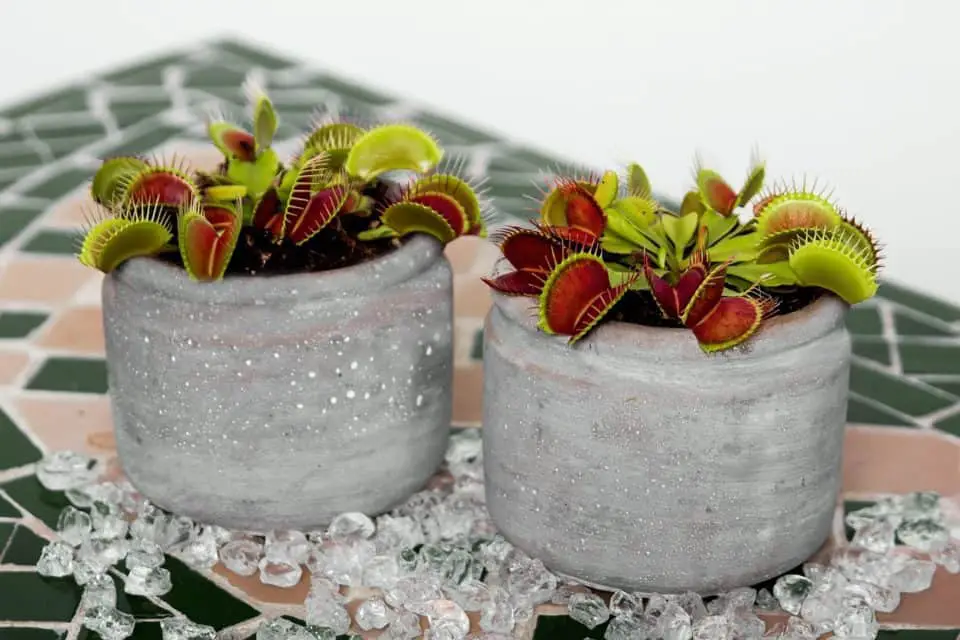Some links in the post are affiliate links and I get a commission from purchases made through some links found in the post.
Meddling insects can be quite a nuisance if they overgrow in your yard. They damage your plants especially the fruit-bearing ones and shooing them off can be tiresome.
If you’re tired of hunting flies with a flyswatter and need a natural solution, then you could grow carnivorous plants.
Carnivorous plants as the name suggests, eat or feed on bugs and small insects.
They trap and eat them away with the aid of digestive enzymes they secrete. However, choosing the best carnivorous plant for your garden can be quite some work.
Few carnivorous plants are well oriented to be planted close to your home. You need to choose the appropriate plant since different plants need different environments to grow.
Carnivorous plants require distilled water with minimum salts to drink. They grow optimally in nutrient-poor acidic soils.
Since they feed on insects, they have stunted growth if not fed an adequate number of insects.
However, they seldom die if deprived of insects. Feeding them too much of large insects or non-insect foods can make them die.
Carnivorous plants do well in bright sunlight and humid conditions. They serve as a great means to keep your house and fruits fly-free.
These need care as they are susceptible to parasite infections as any other plant.
If proper care is given, they can be great investments and will keep you from worrying about flies destroying your precious fruits and foliage.
What are the Best Carnivorous Plants to Reduce Flies?
Following plants can serve as your natural fly killers:
1) Sundews
Sundews (Drosera) are one of the best carnivorous plants to reduce flies.
Sundews can grow up to 10 inches (25 centimeters). They have leaves with sticky hairs which trap the prey.
They are named so because of the dew-like droplets at the tips of their hairs. The tips produce nectar serving as an incredible glue to draw in prey, trap it, and catalysts to process it.
When a bug becomes stuck, the arms loop around it and cover it eventually leading to its digestion.
Cape sundew:
Cape sundews (Drosera capensis) are ideal beginner plants that are easy to grow. They produce lash-like leaves which have brilliant hued arms.
These arms discharge a tacky adhesive. The leaves curl around making a compartment for bugs to get digested.
Pros:
It is the easiest plant to grow and shows a lot of varieties. The cape sundew has long tentacles which can easily trap insects. It is also medicinally significant for warts and sunburns.
Cons:
It takes more than 2 days to digest an insect. It stops growing in cold environments.
Spoon Leaf Sundew:
Spoon leaf sundews (Drosera spatulate) are also one of the best carnivorous plants for flies.
It is a perineal plant that produces rosettes making an overall diameter of about 2 inches. Its leaves bear sticky hairs and It produces white flowers in summer.
Pros:
It is quite hardy and adapts easily to indoor and outdoor environments.
Cons:
It halts growing below 7 degrees Celsius and can rot if overfed with flies.
2) Monkey Cups
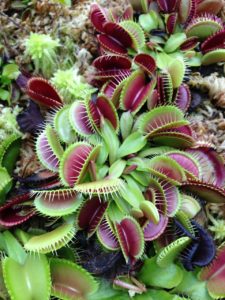
Monkey cups (Nepenthes) are also a good choice as carnivorous plants for flies.
They are native to subtropical regions of Asia and are also known as tropical pitcher plants.
Their unusual name comes from the fact that monkeys are seen drinking from these plants.
They have a typical pitcher plant appearance with a deep leaf shaped into a pitcher and another leaf serving as a lid or hood. It uses a pool of water to trap its prey.
Pros:
These are easy to grow.
Cons:
Their leaves can easily get floppy if deprived of sufficient light. If they become severely dehydrated, the pitchers can droop.
It strictly requires rainwater filling if the water pool dries due to any reason.
3) Venus Flytraps
Venus Flytraps (Dionaea muscipula) is native to North and South Carolina. Their leaves are 8–15 cm in length.
The edges are pivoted along the midline so the two flaps, with barbed teeth, can overlay together and encase any insect landing on them. Venus flytraps are great carnivorous plants to reduce flies.
Pros:
They can survive a month without feeding. It is the most breathtaking illustration of flesh-eating plants of how it gets its prey.
Being one among the modest number of plants able to do extremely quick development, it can snap shut to get even the quickest of bugs.
Cons:
The lower leaves can quickly yellow and decay if provided with minimal light joined by water-logging.
4) Sun Pitcher Plants
Heliamphora plants are pre-adapted to cool house temperatures. They develop well under counterfeit lighting.
The Sun Pitcher utilizes large numbers of similar strategies as other pitcher plants to trap flies. These are native to Guiana highlands.
Pros:
They do not require dormancy. These plants can survive frosts.
Cons:
They are quite difficult to propagate. Propagation by division has limited success. When these plants are divided they can die.
They are not good for the outdoors unless there are tropical conditions. Sun pitcher plants are also poor windowsill and bog plants. They require fertilizers to grow well.
5) Trumpet Pitchers
Trumpet pitcher (Sarracenia) is a carnivorous plant native to North America. The plant has a hood with droplets of nectar.
They fool insects searching for nectar and become stuck to the nectar of the hood. The plant lures them into the pitcher for their end.
Pros:
They are quite temperature-tolerant plants. They are quite easy carnivorous plants to grow.
Cons:
They require bright direct sunlight therefore only grow outdoor. They are unsuitable for growth in terrariums.
6) Butterworts
Butterworts (Pinguicula) are native to highly humid and wet areas. They are native to Europe, North America, North Asia, West Africa, and the West Coast of South America.
They possess sticky, glandular leaves. This lure, trap, and digest insects to supplement the poor mineral nutrition. They are easily the best carnivorous plants to reduce flies and gnats.
Pros:
The Butterworts produce a solid bactericide that keeps bugs from decaying while they are being processed.
Cons:
The plant is sensitive to some minerals and concentrations of salt.
7) Bladderworts
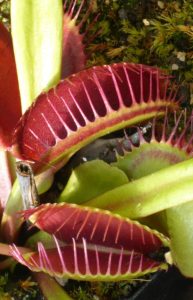
It (Utricularia) is a rootless plant and can grow with less soil. Likewise, this plant doesn’t have a root, it connects to the floor of the water where it can develop.
It’s a floater that streams in the water. The bladders are having minuscule hairs that are set off by little bugs, mosquitos, and water bugs.
The trigger opens a hidden entryway that draws the animals with a sweet substance. When the animals are baited into the snare, they are eaten and processed by the plant.
Pros:
The lowered parts give living spaces to numerous miniature creatures.
Cons:
Bladderwort cannot store energy since it doesn’t have a real root. It uses up all energy produced. So, it needs a high amount of oxygen and constant watering.
8) Catapulting Flypaper Trap
This plant (Drosera glanduligera) has the flypaper properties of the Venus Fly Trap and the marvelousness of a catapult.
The plant utilizes tacky arms to trap its prey. Stuck and caught, the bug squeezes the appendages, which causes plant cells to break under it.
This creates a sling impact. Then tosses the delicious treat into the plant’s middle where it becomes lunch.
Pros:
These are quite interesting species and can the trapping mechanism does provide an interesting sight.
Cons:
It is a troublesome plant to develop. It has tough temperature prerequisites, both for germination and further development.
Plants (particularly seedlings) should be taken care of consistently to look afterlife.
9) Dewy Pines
The dewy pines have a natural habitat of slightly basic soils of narrow coastal or maritime regions. It is native to Portugal, southern Spain, and northern Morocco.
As old flesh-eating leaves pass on back, they produce a stretching stem that resembles the woody stem of a little tree.
Pros:
It is drier than most carnivorous plants, so it doesn’t require frequent watering.
Cons:
The plants appear to be incredibly impervious to bugs. The only issue can be a fungal infection.
That is an indication that the dirt is excessively wet, or the air excessively moist and stale.
They require a huge earthenware pot to grow. This takes up a lot of space. The justification of such a major pot is that grown-up plants will stun, and die if their root frameworks are upset.
10) Cobra Lily Plants
These plants (Darlingtonia californica) grow naturally in boggy areas and near streams in mountains. They are native to the Sierra Nevada mountains.
They are named cobra lily plants due to their upturned cobra head-shaped leaves.
The Cobra lily plants favor cool to warm daytime temperatures and cold or cool evening temperatures. They are also called lobster pot plants.
Pros:
It can grow in a wide range of soils from acidic to basic.
Cons:
These are the most difficult to grow carnivorous plants.
11) Australian Pitcher Plant
Cephalotus follicularis is a special conservative predatory plant. It has various traps framing a tight rosette. Traps are ordinarily .25″ to 2″ in size.
They are frequently burgundy to dull maroon. The hoods are thick and cup-formed and often have red and white stripes.
They cover the little mouth which is fixed with energetic-looking maroon or blackish ribbed lips.
Pros:
It is an exceptional pitcher plant, developing admirably on the window ledge and nursery.
Cons:
It is a hard plant to grow. It can suddenly die if exposed to excessively warm conditions.
The Austrailian pitcher plant is an expensive plant and its seeds are hard to obtain.
12) Rainbow Plants
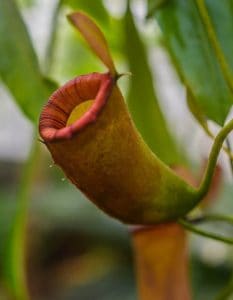
Byblis guehoi are common to acid sands and desert areas like Australia and New Guinea.
It is also called the rainbow plant due to the way its shimmering adhesive-covered leaves and stem glance in the sun.
It pulls in mosquitos and flies, which die due to sticking in the shimmery paste. They’re at that point, processed by compounds for sustenance.
Pros:
It is one of the easiest carnivorous plants to grow. It is a good controller of mosquitos.
Cons:
Damp-off fungus, slugs, and snails can easily damage the plant. So, care should be taken to keep off these pests.
13) Carnivorous Bromeliads
These plants are endemic to Guyana, Venezuela, and Columbia. These are also called carnivorous pineapples.
The leaves structure a water-gathering barrel where bugs are caught and suffocate.
With the assistance of microorganisms to break down the bugs, the plant ingests the supplements. The leaves are fixed with fine red veins giving them a pretty appearance.
Pros:
Grows as a house plant as well as in cool greenhouses. Insects easily mistake the foliage and consider them flowers thus fall prey to them.
Cons:
It is a less researched plant so care methods are developed by experimenting with various soil combinations. This can make care difficult.
What are the Best Carnivorous Plants to Reduce Fruit Flies?
Fruit flies can be pesky and annoying insects. The best carnivorous plants to reduce flies on fruits are the Venus Flytraps.
These quickly trap and suffocate pesky fruit flies. These make your kitchen and fruit basket less likely to be crawling with flies.
These plants digest flies in about 3 days while sundews require a week for complete digestion.
What are the Best Carnivorous Plants to Reduce Gnats?
The best carnivorous plant to reduce gnats is butterwort. Butterworts are gnat-catching machines. These trap the hideous creatures on their elongated leaves.
The leaves have a large surface area with sticky adhesive spread on both the top and bottom of the leaves. This makes them efficient for trapping the gnats.
What is the Easiest Carnivorous Plant to Grow?
The easiest carnivorous plants to grow are the cape sundews.
They are easy to reseed and are not fussy about the conditions to grow. They are also really common and easily accessible.
Final Thoughts
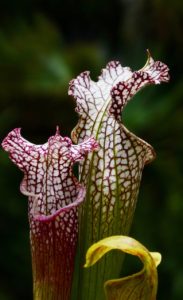 The choice of the carnivorous plant that you plant depends upon how much of a big fly problem you have.
The choice of the carnivorous plant that you plant depends upon how much of a big fly problem you have.
If you have a lot of gnats flying around, then having Venus flytraps and sundews is the best.
You just need to plan what’s the right plant according to your circumstances.
Even if you do not have a pest problem, the carnivorous plants are fascinating and would be the centre of attention whenever they visit your house.
Before you go, here are some more related articles I encourage you to read below to help solve more of your gardening issues:
How To Use Houseplants for Spiritual Protection
Best 10 House Plants for Aquaponics
Top 15 Houseplants with Red and Green Leaves
Top 5 best small trees with non invasive roots.
About the Author:
Saad Ansar
Saad is an avid gardener himself and is a great lover of plants, animals, photography, & people. Currently, he is focused on photographing indoor plants & captioning beautiful outdoor sceneries. He writes and rewrites in-depth articles on nature and science.

